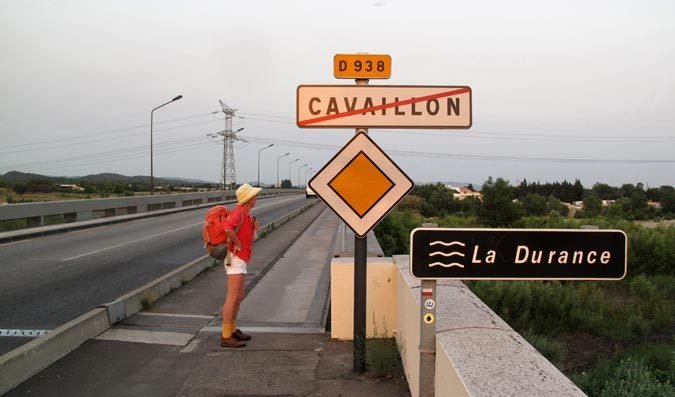
Saturday, 30 June 2012
Distance 28 km
Duration 5 hours 55 minutes
Ascent 173 m, descent 186 m
Map 171 of the TOP100 lime-green series
In the unaccustomed luxury of our hotel room, we were able to have showers before breakfast, something that we never do while camping.
Even so, it only took us 25 minutes from rising to leaving, which we did at 6:10 am. By this time we had been air-conditioned almost continuously for 21 hours, and we wondered how we would cope with the heat of the day to come.
Outside, the air had a touch of freshness, although it was warm enough, and we soon came to the Durance, crossing it on a long concrete bridge.

The water was low at this time of year, with sand bars and stony reefs exposed.
Just beyond the bridge we passed over the autoroute and then turned off with the GR onto a tiny local road that took us along parallel to the autoroute. There were farms at first and further on, a sudden steep forested crag that squeezed us close to the howling traffic.

An hour or so after leaving the hotel we arrived at the village of Orgon, dominated by a shapely church on the hill behind.
The main street had a rather haphazard look although the fine avenue of trees made up to some extent for the dilapidation of the houses.
We asked a man who was looking idly down on us from his balcony, which way to the centre, and he said both ways, but if we were looking for a bar, the one to the left might be open. It was just opening as we got there, but we were not the first customers.
A lone man was just finishing his breakfast — evidently the place was a hotel and he had stayed the night there.
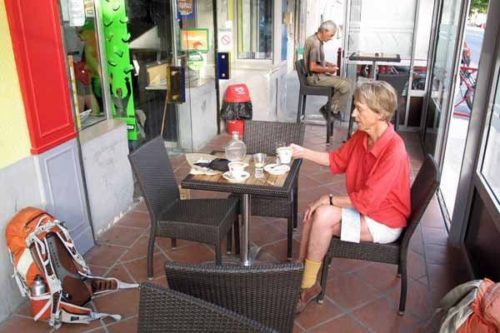
From the substantial pack beside him, his shorts, battered boots and soft hat, we could see he was a walker like us, and when he came past us on his way out we asked him where he was going, but he did not seem inclined to chat.
All the response we got was “St-Rémy”, and he was off up the street, his admirably brown, muscular legs gleaming. The coffee was reviving, even without pastries, and in due course we set off too.
We could see from the map that the GR described two sides of a triangle and also took in a couple of gratuitous climbs, so we decided to stick to the road as far as the next village. After all the climbing we had done in the Baronnies, and with the threat of another day of extreme heat, we went for the line of least resistance.

After the first unedifying kilometre through the streets of the town and up the highway past a large factory and a roundabout, the road shrank to a country lane and it was a pleasant hour’s walk.
We rose a little through a forest of pines, then came out into dry grassland dotted with oaks and olives.
On the horizon the Alpilles jutted up suddenly from the flat landscape like the remains of a dead dinosaur, and all around us we could sense the departed Romans in odd bits of masonry.
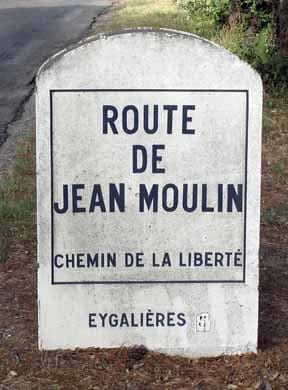
There were stone markers beside the road proclaiming it the Way of Jean Moulin, the legendary World War II resistance hero who had lived nearby before being captured, tortured and killed by the Gestapo.
At the twelfth-century chapel of St-Sixte, solitary on a rise beside the road, we paused to admire its simplicity and the beautiful way it blended into its surroundings.

Here the GR rejoined the road and we continued along it into the village of Eygalières which was already visible ahead.
The old village, with its church and ruined château, stood on the top of a stony hill, but the part that interested us was the lower street where the shops and bars were.
We visited the boulangerie and then sat down in the cool porch of a bar for a proper second breakfast, with pastries.
It was 9:30 and the place was full of Saturday morning drinkers. The main street was attractively shaded by plane trees, at odds with the bleached, open country we had just walked through.

Our fellow pilgrim strode in, swallowed a Coke and departed while we were still sitting at our ease.
We left the village on the road, ignored the GR when it crossed over, and after a couple of kilometres came to a T-junction.
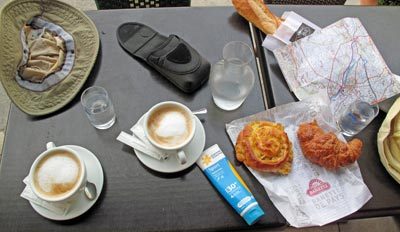
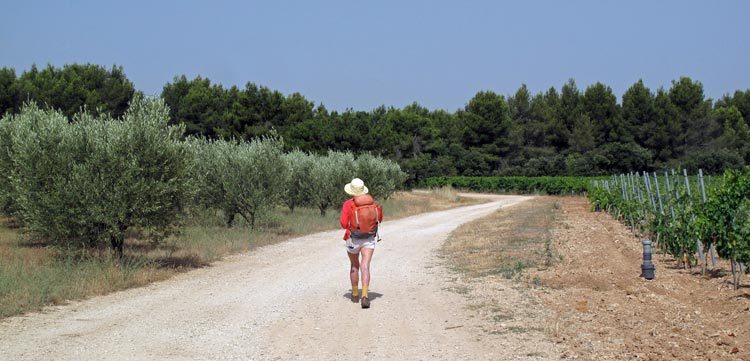
On our map there was a wavering black line continuing straight ahead and joining another road further on. We hope this would be a track that we could take, and it turned out perfectly.
It was a rough dirt farm road weaving along amongst fruit trees, olives, vines, then wheat and open grassland.
The Alpilles were almost within touching distance on our left and we passed a chapel buried in a tangle of trees just as the track joined a small gravel road. We caught a glimpse of the other walker ahead, but then we stopped for a drink and lost sight of him.

As we swung along we noticed a lot of little aircraft in the sky, many of them gliders. We were passing an aerodrome where the local enthusiasts practised their art. The thermals must have been monumental on such a scorching day.

We had almost run out of water, even though we had refilled our bottles at Eygalières, and by the time we left the flat grassland and climbed into the outer streets of St-Rémy, we were feeling very hot and tired.
Not knowing where the camping ground was, we asked a couple of half-grown kids who were sitting on a wall.
They were just visiting St-Rémy and knew nothing, so they fetched their mother, who was equally ignorant and fetched her mother, who actually lived here.
The old lady told us that there were three camping grounds, but the nearest one to the centre was down the hill on the Cavaillon road. She was very insistent in her offer to drive us there but we declined just as insistently, and she ended up pressing a large bottle of iced water on us, with instructions to hold the cold water in our mouths before swallowing it in case it gave us a heart attack (we no doubt looked pretty dreadful).
In the few minutes that it took us to walk down a lane to the town, we had almost drained the two-litre bottle, pouring the icy water straight down our throats without regard for our hearts. The circular main street was packed with diners and drinkers, but we were not to be diverted from our mission to find the camping ground as quickly as possible. We needed to lie down.

There were signs to various camping grounds, with no distances indicated, so we asked a café owner, as everyone else in the street seemed to be a tourist. He told us to go back and follow the Cavaillon road for two kilometres – unwelcome news, given that the old lady up the hill had said it was 200 metres from the centre.
We set off doggedly and had hardly got into our stride when we arrived at the place (the Pegomas). It was indeed only 200 metres away and to our tired eyes it was like a vision of paradise.
At the front, a large azure pool was set like a jewel in white paving and surrounded by deck chairs and palm trees. The office beside it was in the Mediterranean style and we felt we could have been back in a Roman villa of two thousand years ago.
In the office we discovered that all this elegance came at a cost – the minimum price was €25.50. I asked whether they had a special price for walkers but the answer was no. I muttered the word “rip-off” in English to Keith in the hope that the man might know it, but he gave no sign. He showed us a map of the place and asked us to choose a plot and then come back to pay.
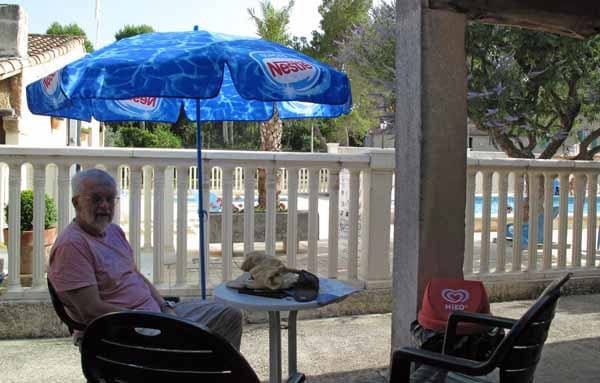
Most of the plots were bald, dusty and lacking in shade but we found an adequate one and went back. By this time the man had been joined by a woman and she asked us where we were going. “Compostela’, we lied, and the bill suddenly went down to €15. Perhaps the man had understood my English slang after all.
The afternoon, which was fiendishly hot, we spent comfortably, either in the shower, asleep under a tree or sipping drinks at the little snack bar near the pool, where the first day of the Tour de France was playing on the TV.
At about 7:30, although it was still hot, we strolled slowly into town in search of dinner.

There was a feeding frenzy going on, as there had been at lunch time, on the circular street that enclosed the old town, but we were not impressed with what was displayed on the menu boards as we walked by.
Through a stone archway and down an alley we found a pizzeria that seemed better and, like most French pizzerias, offered a full menu. We chose lasagne for €8 each, preceded by glasses of rosé and a delicious salad with garlic dressing.
It was a lovely way to end a day of exertion and stifling heat.

Back at the camping ground, we had a new neighbour – our erstwhile companion from Maubec, the lone pilgrim in sandals, who had only just arrived.
He said he had lost his way and walked an extra 12 or 13 kilometres, but even so, he must have started late. His feet, which he proudly showed us, were deeply tanned in a striped pattern, as he has no other footwear than his sandals.
There was no sign of the smooth-legged walker from Orgon, who was no doubt staying in a hotel. “Un pèlerin de luxe!” exclaimed our friend with a laugh.